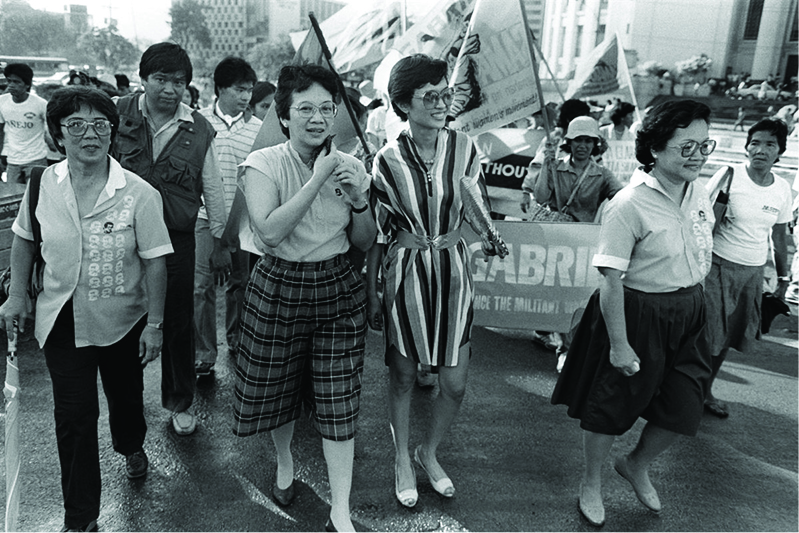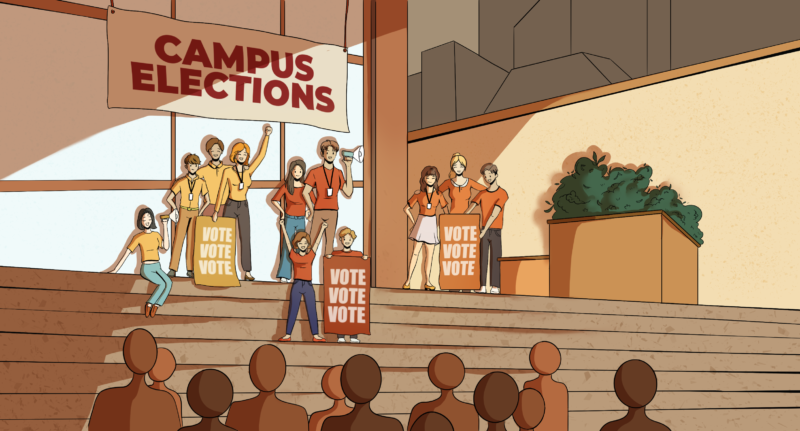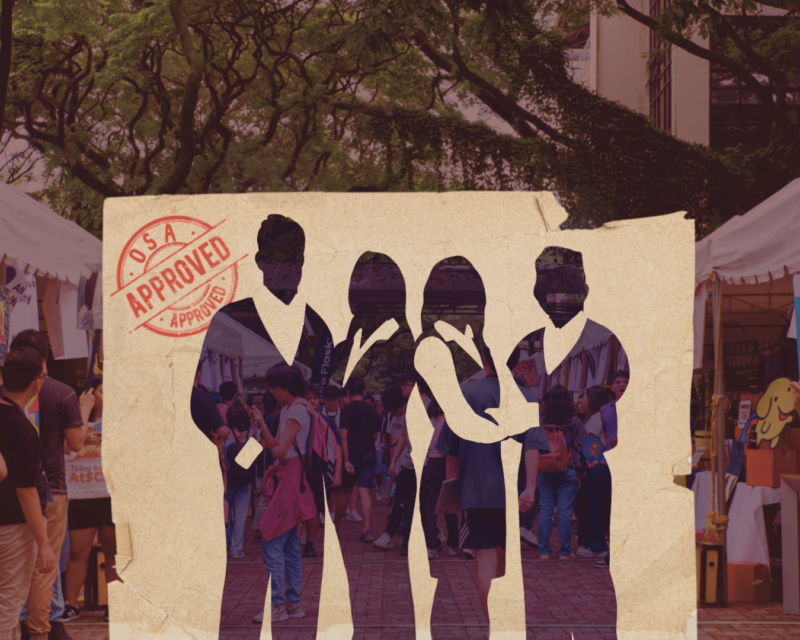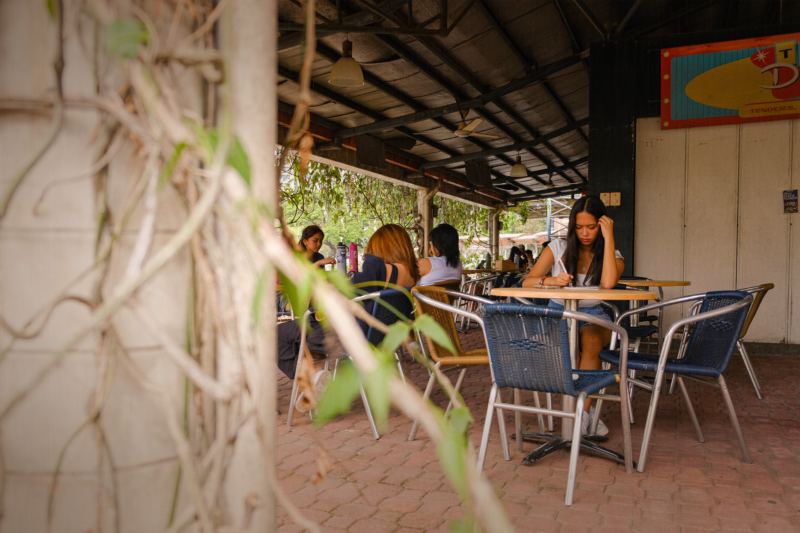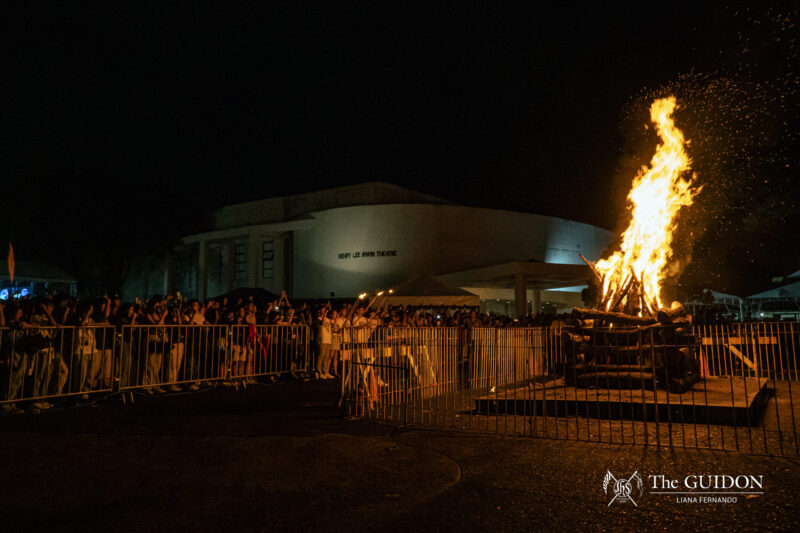“Feminism? Hah, just a bunch of lesbians burning their bras for media exposure,” Tess Lugos wrote sarcastically in her article “Towards a feminist philosophy” in the 1987 August-September issue of The GUIDON.
Lugos had just signed up for the course “Philosophy of Woman.” According to Lugos, the course was often met with “derision and incredulity,” perhaps because gender inequality was still rampant, despite feminist triumphs the year before.
The 1986 EDSA Revolution was a demonstration not distinguished by gender or social class. It was called People Power precisely because it united the people of the Philippines against a major political force: The Marcos regime. Men and women—young and old, rich and poor—joined hands in rallies and movements to participate in one of the greatest peaceful revolutions the world has ever known.
It was in this era that almost every front page of The GUIDON featured Corazon Aquino, the eleventh President of the Philippines and the first female president in Asia. Headlines such as “Support groups for Cory formed,” “Ateneo confers degree on President Aquino” and “Cory’s pressing problems” flooded the publication.
If the articles weren’t directly about Aquino, they would positively address the Ateneo’s female students with titles such as “Meet the women in power,” and “The ladies may stay.”
The immediate effects EDSA had on the feminist movement can clearly be seen in documented history, but today its long-term effects are debatable. For the most part, women and men are now seen as “equal,” with equal voting rights and opportunities to education. However, gender equality is not only measured by legalities, but also by liberties.
EDSA
The EDSA period was a subtle turning point for the feminist movement.
According to Jenina Ibañez, literature junior and Executive Vice President of the first Gender Equality Society (GES) in the Ateneo, people usually look up to accessible female icons for feminist organizations. Back in the 1980s, the most prominent and accessible icon was Aquino.
Many would consider Aquino one of the greatest women of her time. In 1986, the Ateneo granted her an honorary degree in Humane Letters for “the dimension Aquino had given to the definition of Filipino womanhood,” according to an article from The GUIDON entitled “Ateneo confers degree on Aquino.”
Dionne Co, literature senior and GES President, says, “I’m pretty negative about Cory Aquino based on what I heard about her, at least in terms of her political rule. But as a first woman president in the Philippines, [it is important to note that] she did pioneer that kind of idea that women can be leaders too.”
Though Aquino never proclaimed herself a feminist, she came into power with the support of feminist organizations. Many women’s organizations either started or were revived during the 1980s, and women’s issues were discussed and led by a more empowered women’s movement. On March 8, 1986, International Women’s Day, around ten thousand women marched in Manila to affirm Aquino’s victory as a victory for the women’s movement in the Philippines.
Aquino’s presidency also allowed for a more open political climate in which the women’s movement could thrive. According to The Official Gazette, the official journal of the Republic of the Philippines, women’s presence in public office—especially in the House of Representatives—increased after Aquino’s rise to the presidency. A number of politicians were also high-profile feminists who would pave the way for more gender-sensitive legislation. It was in this period that the Republic Act 7192 or Women in Nation-Building Act was passed. The act promoted the integration of women as full and equal partners of men in development and nation building.
Microaggressions
While the main issues regarding sexism in the 1980s were more about women’s political power and less about how women dressed, Co remarks that the same does not hold true for today’s society. She says, “Sexism has evolved into a different form.”
Co says that sexism in the Ateneo can be found in its microaggressions. These refer to the everyday interactions that can be interpreted as small acts of non-physical aggression between those of different races, cultures and genders. For instance, a simple, “That outfit’s pretty slutty”—usually disregarded in light conversations with friends—can be considered slut-shaming, the admonition of women for presenting themselves as more sexual than society deems acceptable.
“If you walk around campus thinking that we are already all equal, then you’re just blinding yourself to the sexism,” says Ibañez.
Although the Ateneo’s history isn’t exactly full of gender equality news and triumphs, Ateneans have been doing their part to keep the cause alive on campus. In July 2012, a minor in gender studies was proposed to the Central Board of the Sanggunian. It has been more than a year since that proposal was brought up, but not much progress has been made since then. Development studies majors now have the option to choose gender (with gender relations and gender studies as core subjects) as a half-track. The Sociology and Anthropology Department has classes focused on gender studies, as well.
Without an actual course for gender studies or a women’s studies department like in other universities, students have found other outlets for their concerns on their own throughout history.
When Cory Aquino rose to the presidency in 1986, Atenean women took the opportunity to follow Aquino’s lead. Students created support groups for Aquino. At one point, there were three ladies leading three Atenean organizations, namely Heights, Tugon and the Management Engineering Association. The women of the Inter-school Business Association also won against the men of Aiesec Ateneo in a debate on the question, “Should women be expelled from the Ateneo?”
Similarly, when the popularity of sexist posts on Ateneo de Manila Secret Files increased this year, Co and Ibañez took the opportunity to create GES. From two to seven to 63 members, GES has grown exponentially since the release of their first promotional poster last January 26.
Ibañez says, “We started seeing a lot of misogyny on campus, and after all that sexism we just realized that it’s important for us to start this organization to get people together and to inform people.” She adds that sexism exists on campus, not always because of students’ insensitivity or cruelty, but because of the lack of awareness about sexist behavior. GES aims to educate the Ateneo community through talks and projects about gender equality.
While gender equality may be the main advocacy of those who join GES, Ibañez and Co say that it is not the only issue they’re willing to address. Ibañez mentions that she once heard that queer theory stems from feminist theory, “because when you talk about things like gender, we’re already going into issues of sexuality and sexual orientation.” By addressing feminist theories and issues, it is inevitable that other concerns like queer issues would be discussed as well.
Questioning stigmas
“The [Ateneo] has to recognize these issues, because the university should really look into the fact that these stigmas still exist,” says Ibañez.
Stigmas such as “women in power are frightening” or “feminists are angry” sabotage the constant struggle for gender equality. Co advises everyone interested in gender issues to reflect on and start questioning their beliefs and actions—from insulting girls who wear short shorts to shaming women who speak their minds.
To drive the point home, Ibañez quotes Gang Badoy Capati to describe the state of gender equality in the Ateneo. Capati is the founder of RockEd Philippines, an alternative education group that addresses social issues through music. “[She] said something about how everything is a muscle, and it’s all the sum of the strongest things. If you want to be stronger, you have to be more flexible. If you want to be more flexible, you have to stretch more. So you have to stretch your mind and stretch your heart.”
Perhaps all the Ateneo needs is the will to stretch the bounds of gender equality and the feminist perspective on campus, just as its students did in 1986.
The women of the EDSA Revolution
by Eugene G. Ong
The EDSA Revolution was undoubtedly a proud moment for our nation, and the bravery of a number of women across the country helped tremendously in bringing that moment about.
Corazon Aquino
The very symbol of the revolution, Cory Aquino’s ascent from being a “mere” housewife to the presidency continues to captivate the nation to this day. Known as a woman of grace who once stirred the United States’ House of Representatives to a standing ovation, she nevertheless showed remarkable tenacity in navigating the nation through the tough years of the late 1980s and early 1990s.
June Keithley
Radio Bandido was a key instrument of the revolt, and it was June Keithley’s voice that brought real, uncensored news to the masses in spite of the danger to her own life. Not one to give up easily, she stayed on air in the midst of physical exhaustion. Keithly spent the last years of her life fighting cancer and died on November 24, 2013.
Delia Regidor
While most of the nuns who stood against tanks with only rosaries, food and flowers remain anonymous to this day, one has been identified: Sister Delia Regidor. Regidor, a member of the Missionary Sisters of the Immaculate Conception, she currently resides in Montreal, Canada as a vicar general of her order.
Yolanda Lacuesta
Blockaded on the ground by government troops, pro-Aquino soldiers led by Juan Ponce Enrile and Fidel Ramos would have starved if it were not for the efforts of civilians like Yolanda Lacuesta. Despite her mistrust of the military, she heeded the rebels’ plea for food and endured the crowds to resupply the rebel camp.
What do you think about this story? Send your comments and suggestions here: tgdn.co/2ZqqodZ

